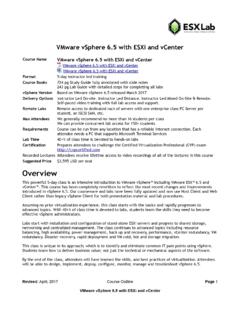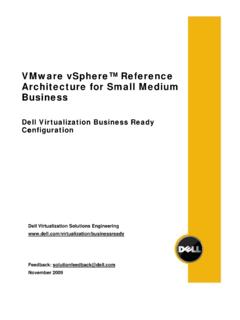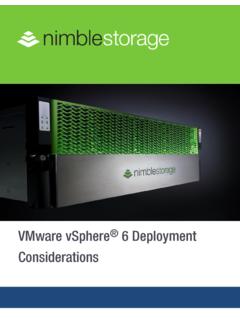Transcription of Hitachi Storage for VMware vSphere Virtual Volumes (VVol)
1 Hitachi Storage for VMware vSphere Virtual Volumes (VVol). By Hitachi Data Systems May 2016. 1. Contents VVol 2. Architecture and Technical Details .. 5. Product Compatibility .. 20. Additional Resources .. 23. 1. VVol Fundamentals 1. What is VMware vSphere Virtual Volumes (VVol)? VVol is based on a new integration and management framework between vSphere and the Storage system. VVol virtualizes Storage area network (SAN) and NAS devices by abstracting physical hardware resources into logical pools of capacity (called Virtual or VVol datastore) that are more flexibly consumed and configured to span a portion, one or several Storage systems. It implements an out-of-band bidirectional control path through the VMware vSphere API for Storage Awareness (VASA) and leverages unmodified standard data transport protocols for the data path (for example, network file system, iSCSI, Fibre Channel).
2 On the Storage system side, two new components are added to the Storage environment: VASA provider for integration with VASA application program interfaces and protocol endpoint, which allows the Storage controller to direct I/O to the right VVol. On VMware vSphere , there are three dependent features: VASA, VVol and VMware 's Storage policy-based management. In order to create policies at the vSphere level, a set of published capabilities must first be defined in the Storage system. Once these capabilities are defined, they are surfaced up to vSphere using the Storage vendor VASA provider. The Virtual datastore (sometimes referred to as the VVol datastore) defines capacity boundaries and access logic. It exposes a set of data services accessible to the Virtual machines provisioned in the pool.
3 Virtual datastores are purely logical constructs that are configured while in motion (when needed) without disruption. They do not need to be formatted with a file system. VVol defines a new Virtual disk container ( Virtual volume), which is independent of the underlying physical Storage representation that allows for finer control. In other terms, with VVol the Virtual disk becomes the primary unit of data management at the Storage system level. This turns the Virtual datastore into a Virtual -machine-centric pool of capacity. It becomes possible to execute Storage operations with Virtual machine granularity and to provision native Storage -system-based data services to individual Virtual machines. This approach allows administrators to provide the right Storage service levels to each Virtual machine.
4 2. What would be a few very compelling technical and business incentives to transition to VVol management? 1. The list below presents some prominent technical advantages and abilities, which are only available with VVol management: 2. Deliver granular quality of service (QoS) per Virtual machine disk (VMDK) as opposed to per LUN. for better performance management. 3. Efficiently perform Storage operations per Virtual machine (VM) for higher VM density. 4. Simplify operational environment and automate the VM resource-provisioning process through policy-controlled automation, removing any possibility of error due to human intervention. 5. Enable Storage offload services to overcome data management challenges. For example, allow 2. superior noninvasive VM snapshot management.
5 Which is further enhanced with Hitachi Virtual Infrastructure Integrator. 6. Allow automated space reclamation on VM deletion. 7. Deliver differentiated data services to different tiers of a multitier VMs. For example, the database and log file of a multitier SQL VM can be placed on Tier 1 Storage , while the operating system can be placed on Tier 2 Storage resources for enhanced efficiency. 8. Accelerate efficient deployment of private cloud services with policy-based VM provisioning. 9. Employ policy-controlled automation of Storage tiering (road map). 10. Increase visibility into Storage services for VM admin. 11. Support better visibility into VM or application service level agreement (SLA) requirements for administrators to provide higher operational management experience for business services.
6 3. How has Hitachi Data Systems (HDS) been involved with VMware vSphere Virtual Volumes (VVol)? VVol is a Storage management framework devised by VMware . HDS has worked with VMware as a strategic partner to deliver VVol implementation for both block and file Storage over the last 3 1/2 years. Go to the VMware press release for more information about the availability of VVol with vSphere 6 with reference to Hitachi Data Systems. 4. Why choose Hitachi Data Systems for VVol? Choose HDS for VVol for zero-worry IT services. Running VVol on Hitachi infrastructure ensures a robust, reliable enterprise journey to a software-defined, policy-controlled data center. The combination of VVol policy-based automation and trusted, high-performance HDS. infrastructure solutions provides the continuous infrastructure foundation organizations will build upon with confidence.
7 As organizations increasingly deploy converged infrastructure solutions, they look forward to the benefits of this solution's integration with Hitachi Unified Compute Platform. The combination creates a more agile and flexible data center. It also helps IT get to production faster, automate operations, and provide real-time business insights. 5. What are the key points of a VVol implementation by Hitachi Data Systems? Reliable, robust implementation of VMware vSphere API for Storage Awareness (VASA). provider. Replication services for failover and failback VVols with near-zero recovery point objective (RPO). Continuous availability of VASA provider with vSphere Fault Tolerance (FT) and High Availability (HA). Flexible Storage capability catalogue to deliver application-required data services.
8 Tailored interfaces for both Virtual machine administrators (web user interface or web UI). and Storage administrators ( Hitachi Command Suite). 3. Multitenant (resource group for block and IP multitenancy for file). Unified VASA provider package for file and block with single sign-on web UI access. VVol scalability (see Table 1). Table 1. VVol Scalability in Hitachi Implementations Serial Storage Storage Scale (Active Scale (Snapshot or Number. Platform System VVol) Clone). 1 Hitachi NAS HNAS 4100 400,000 10,000,000. Platform HNAS 4080. (HNAS). HNAS 4060. 2 Hitachi VSP G1000 64,000 1,000,000. 3 Virtual VSP G800 16,000 100,000. 4 Storage VSP G600 4,000 100,000. 5 Platform VSP G400 4,000 100,000. 6 (VSP) VSP G200 2,000 100,000. G series 7 VSP VSP F800 16,000 100,000.
9 8 F series VSP F600 4,000 100,000. 9 VSP F400 4,000 100,000. 6. What licensing is required to get VVol support in Storage systems? VVol management framework will be offered as a no-charge item. (That is, there is no licensing fee for Hitachi Storage Provider for VMware vSphere or VASA Provider.) Customers need to ensure they have the appropriate Hitachi platforms that support VVol (that is, VSP. G1000 and/or Hitachi NAS Platform). For other or older Hitachi Storage platforms ( Hitachi Unified Storage (HUS) VM, VSP and HUS 100 family) or indeed third-party Storage , we provide an option to virtualize with VSP G1000 or virtualize with supported HNAS system cluster gateway to surface VVol support. 7. What is the Hitachi Data Systems (HDS) value proposition for VMware vSphere Virtual Volumes management framework?
10 Simplifies Storage operations. Separates consumption and provisioning. Enables end-to-end visibility. Simplifies delivery of Storage service levels. Allows finer control, dynamic adjustment. Improves resource utilization. Maximizes Storage offload potential. 4. The HDS approach is to provide an enterprise-level, trusted, reliable and zero-worry implementation (see Figure 1). We embolden the Storage administration team with rich, Storage policy-based management Storage capabilities control. We leverage the VVol and Storage Policy Based Management (SPBM) framework to further elevate the rich data services that we bring to a VMware environment (global-active device, Hitachi Virtual Infrastructure Integrator, efficient data movement and efficient Storage -system-based cloning).
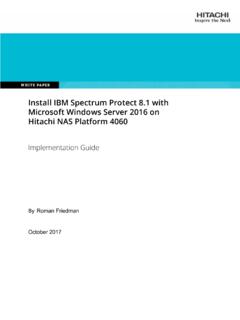


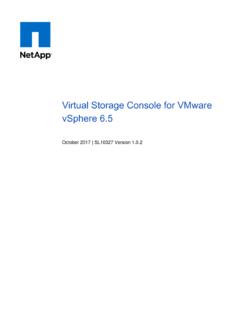
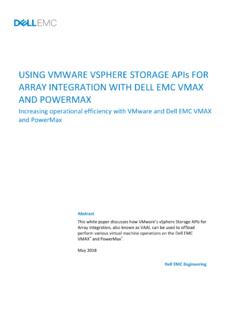
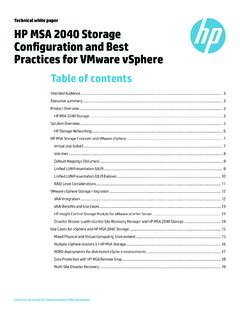
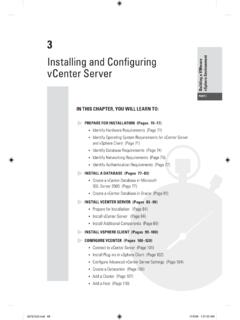
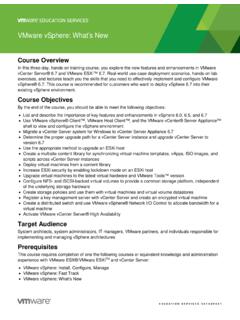
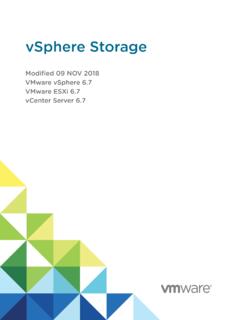
![VMware vSphere: Install, Configure, Manage [V6.7] H9TG1S](/cache/preview/f/3/c/6/b/5/5/e/thumb-f3c6b55ee4cf7c515d9a57a30862569e.jpg)
